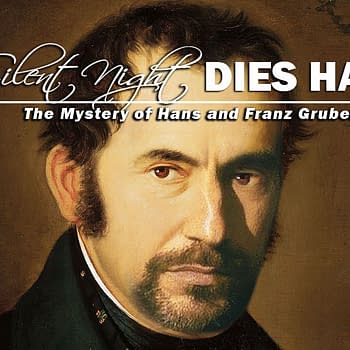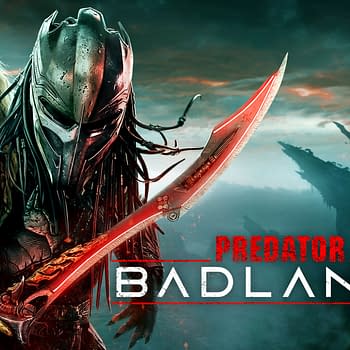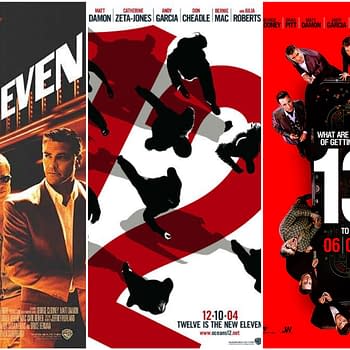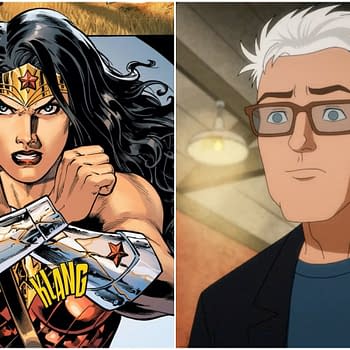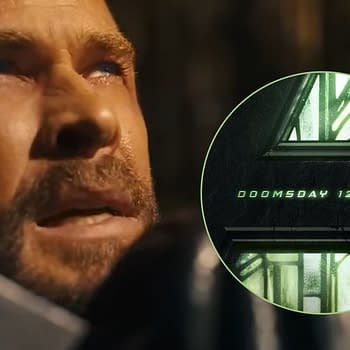Posted in: Movies | Tagged: film, garth ennis, sdcc, stitched
Interview: Garth Ennis Unwraps The Secrets Of His First Film, Stitched

Stitched will premiere at SDCC on Thursday, July 21st at 8.15pm in Room 6DE. Garth Ennis will be there, as well as cast and crew from Avatar Press and Mischief Maker Studios. This is the first time San Diego Comic Con has premiered such a film, on site. The DVD will also debut at San Diego and is available for preorder right now.
Until then, let's see if we can find out more about this nasty little secret Garth has in store for us. Keith Davidsen interviews him for Bleeding Cool:
Where did the idea come from? What was the impetus for telling the story of STITCHED?
Stitched began as little more than a series of images, really – three little figures stumbling across a barren landscape, exhausted people struggling to survive against the odds, blood on the rocks of the mountains, and lots of frantic, close-in combat. I realized straightaway that it was going to be a war story, primarily, and I liked the idea of a contemporary one with some degree of relevance to the current state of the world. I knew it would have a small cast, that our heroes would be cut off and on their own. That was pretty much how it developed initially.
The characters of STITCHED are soldiers serving in Afghanistan. As a writer known for his war stories, what is it about military combat that fascinates you?
I think it contains a level of drama that goes far beyond fantasy. The knowledge that people have done and continue to do these things gives the war story an intensity that I don't think can be matched. We're talking about the most extreme edge of human experience here, the often literal border between life and death.
From idea to final script, how long did the storytelling process take?
There's probably about ten days work in it. Initially it was going to be a feature-length straight war story, and I wrote a treatment as such. Then the horror aspect was added, and after that came the notion of a short film – so there was a bit more story development than I'm used to before I actually wrote the script.
Who were the instrumental people involved in making the STITCHED film happen?
Most obviously, William Christensen, without whom the film just couldn't have happened. Brian Pulido, who gathered the team and made the project a reality. Francisca Pulido, who found us the perfect location. Director of Photography Adam Goldfine, who I relied on heavily as I learned how to put shots together and move the story along visually.
Who approached whom? Did you pursue the film project with Avatar Press / Mischief Maker Studios, or vice versa?
Initially, it was a kind of mutually accidental thing. William was trying to get me to commit to doing new series for him, as usual, and I was turning him down for fear of over-committing myself, as usual.
So, slightly exasperated, he asked me what it was I would like to do, and I said I'd always fancied a crack at directing a film. Instead of pissing himself laughing, he said that he'd actually been thinking along similar lines – he knew some people with a good deal of expertise in low-budget film-making, and he'd been wanting to dip a toe in those waters. So after this happy coincidence, William got in touch with Brian Pulido, who began with a lot of helpful advice and then put the team together so we could go to work.
Was there a lot of give-and-take in working with Brian Pulido, who himself had transitioned from comics (notably, Chaos Comics and LADY DEATH) to film work?
I found working with Brian terrific, although our mutual background in comics didn't really enter into it. He's an extremely cool-headed, very analytical person – he doesn't get rattled, he just looks, evaluates, decides, all very quickly indeed. I could actually watch him doing it on set – a situation would develop or someone would ask him about something, and he'd almost instantly and very calmly come back with, "Well, okay, so we'll do A, B, and C." I think a big part of the production's efficiency and effectiveness came from Brian's sheer professionalism.
During the pre-production stages, how did you handle the learning curve of picking up the directorial process? Were there a lot of technical skills that you had to learn?
I learned a lot from Brian, Adam and A.D. Zach Lemon. Brian and Zach told me what I needed to know in terms of the process, the sequence in which things get done, technical terms, and so on. Watching Adam put his shots together when we walked the location before shooting began, I saw how one shot would relate to another, how the storytelling process would be served.
Let's talk about our primary cast: Tank Jones (Pruitt), Lauren Alonzo (Cooper), and Kate Kugler (Twiggy). When they auditioned for the roles, what did you see in each actor that made them fit the part?
They all underplayed it, which I appreciated very much. Some of the other actors who auditioned were turning short, snappy lines of dialogue into tormented Shakespearian soliloquies, but these three nailed their roles straight away. Tank gets Pruitt's pain and guilt at – as he sees it – having failed in his role as commander, enduring the agony of his injury alongside the mental anguish. He allows his resentment to show at just the right moments, but his concern for his crew's well-being also comes through. As Cooper, Lauren manages to convey the frustration the character feels without overdoing things – she buries her own fears out of sheer practicality, and at the same time can snap into all-business mode in an instant. Cooper is much more formidable than even she knows. And Kate is perfect as Twiggy, scared and confused and always very human. You can see her fighting that internal battle between panic and control, facing the misery of knowing she's going to lose it.
On the set, what was the experience like working with live actors?
Simply fantastic. They were all very talented and they all got the idea of STITCHED straightaway, which helped enormously. No one needed much in the way of notes; what I did give them they took on board and assimilated instantly. I found that part of the process the most rewarding, actually, feeling like you can step into the story and say to the characters – "Yes, just like that," or, "Maybe a little more of this."
In getting behind the camera – did it feel foreign or intuitive?
I felt very much at home behind the camera. Watching the action develop, making mental notes as to how to alter angles and performances. It seemed like a very natural process in terms of moving the story along, getting what you need to tell it.
How long did the filming take?
Three full days, 4:00am to sundown. The hardest work I've done in a while (and most people on set were working harder than I was). But very, very rewarding.
Was there camaraderie off the set with the cast and crew?
I spent a lot of time during pre-production with Brian, Francisca, Adam, Zach, and my assistant Luke Fisher, and they're a tremendous bunch. It was nice to be learning so much from people that I liked immediately. Once we actually started shooting, I saw that Zach was running a very efficient set and that everyone knew what they had to do, and you could see that adding to the general good humor – that sense of people coming together to do something they really want to.
So off-set, that translated into a lot of easy, good-natured camaraderie that I found extremely heartening.
Did the filming go as expected, or were there unexpected challenges on the set?
We pretty much got what we wanted. I think things went very well. We were certainly working hard and getting a lot more shots than what I was told was normal. The one problem was the air traffic; there are a couple of airfields and an airport nearby and the sound disruption did cost us time. We had a couple of military veterans in the crew, who told us that you get a lot of high flying jets in Afghanistan and the noise of those would be nothing unusual, so the big airliners were fine – but the little droning prop planes would be completely incongruous. When they happened along we had to put down tools and wait them out.
How did Arizona's desert environment and climate affect how you shot the film?
Francisca found us a terrific location that matched Afghanistan's mountain terrain very nicely. The country's not what you might think – many people imagine Afghanistan as barren and rocky, but actually there's a good deal of greenery and desert scrub. The one problem was the huge bastard cacti that grow everywhere, which are definitely not authentic. We had to compose some of our shots very carefully to edit those out.
What would be a singular cherished memory that you have from the set of STITCHED?
Too many to choose. William Christensen watching the set come together and saying, "People, doing stuff, building things! With my money." Zach almost killing himself chain-smoking so he could breathe into a tube to simulate the gunsmoke from Lauren's pistol. Andy DeCarlo's entrance as Barclay, descending the little slope into a scene of near-carnage and blithely announcing himself with "Evening!" And getting that last shot with the little band struggling up the slope into the oncoming night – that felt like a particularly good one to end the shoot on.
Were there outside influences on your directing? Perhaps other directors or films that influenced how you shot STITCHED?
In terms of directors, I'm not sure. I was so busy learning the ropes that it was hard to stop and think about influences; not in the way that I can as a writer, with twenty plus years of experience under my belt. As for films, STITCHED is supposed to follow in the tradition of tough, lean low budget action flicks, with a little group of characters on their own and up against it: things like Dog Soldiers, The Beast (sometimes called The Beast Of War) and the beyond-obscure 84 Charlie Mopic.
You're based in New York, and Mischief Maker Studios is located in Arizona. Were there challenges after filming to creating the final cut of the film?
Not really. Brian and Nick Gallegos had been excellent about keeping me updated with each cut of each scene, so I could give notes pretty much straight away.
What are you reflections on the process of adding music to final piece?
That was very interesting; I learned a lot about what can and can't be done with film music from composer Jim Casella. On Stitched we went with the notion that less is more, particularly in the opening scene.

The comic book will retell and expand the story from the short film in its first issue, then move on to the rest of the plot. We'll see the British and Americans fight a running battle against their pursuers, learning more and more about the Stitches and their handlers. They'll discover what's really going on up in the mountains and what the Stitches are being used to protect – something much nastier than black magic. We'll find out all about Pruitt, Cooper, and Twiggy, and also about Barclay, Dave, and Baz, seeing exactly what makes each of them tick. And there'll be bags of action, culminating in an all-out final battle that not everyone will survive.
What are your thoughts on reuniting with Mike Wolfer, your creative partner on the previous comic book series, Streets of Glory?
Mike always does a terrific job. He's got a great sense of character and excellent storytelling. He seems to have an affinity for military stories, being more than comfortable with all the uniforms and hardware. And his horror stories are always worth reading; he communicates unpleasantness and terror extremely well.
Avatar Press currently publishes CROSSED, a horror franchise which you created and personally hand-pick the contributors. What would you consider to be the biggest difference between the STITCHED and CROSSED titles?
Scale. CROSSED is an epic tale of worldwide catastrophe, of humanity descending into chaos and the few survivors facing an unimaginably dreadful enemy. STITCHED is a tight, claustrophobic story of survival against the odds with lots of frantic action and desperate struggle.
Now that you've made one of your creative visions into a film, what does that make you think about the prospect of other filmmakers adapting your work to movies?
It hasn't really changed the way I feel about them being adapted, which varies from book to book. Whoever does PREACHER's really going to be up against it, in terms of sheer complexity: there are so many characters and situations that can't be cut without dramatically altering the feel of the piece. THE BOYS should be a bit simpler, five characters kicking the shit out of superheroes – with all these hero movies out at the minute, half your work's done for you. CROSSED is an easy one. So's THE PRO.
Reflecting on the filming experience, were there storytelling skills you picked up behind the camera that that may influence how you craft comic book stories in the future?
Not really, no. In comics you remain very much in the hands of the artist – you're not there when he's drawing, the way you are when the action's unfolding on a film set.
As the movie's premiere at San Diego Comic-Con approaches, what are you feeling?
Haven't been to the San Diego con in twelve years, so this is an interesting way to come back.
How do you expect you'll react to a packed house of fans at the premiere?
With total astonishment, I'm expecting three people and a cat. That's what Brian Vaughan likes to call "cautious pessimism".
Stitched will premiere at SDCC and is available for preorder now. You can find out more at www.FearTheStitched.com.








